
Casablanca, Morocco to Bone, Algeria with Jerrie Mock in 1964 · · PAGE 4.
March 30, 1964: The first page of chapter 8 of my
hard-cover book has a map of the proposed flight segment from Casablanca to Bone,
Algeria. There are two dashed lines on the map. One line shows the proposed
direct route over land and another shows the route she flew along the shores of the
Mediterranean Sea. She had a one-day delay at Casablanca due to bad weather.
Jerrie departed on March 30th with her flight path along the northern coast of
Africa to avoid the mountains and the icing conditions at the required altitude to get
across them. She describes the route very well. This is where I used Google
Earth to see some of the seaside sights for myself as they exist now or in recent
years. The images on Google Earth are linked to geographic coordinates which made
GPS waypoint entry easy for me. You can put the mouse cursor on a point of interest
on the Google Earth aerial photos and you get GPS latitude and longitude for that location
at the bottom of the screen.

Here is an aerial photo from Google Earth dated August 14, 2014 showing her
destination, the Bone airport. My mouse was centered on the longest runway but it
does not appear on the snapshot below. The information at the bottom of the screen
capture gives the latitude, longitude, field elevation of 8 feet, and describes this view
as if you were flying over the airport at 24,502 feet looking down. I doubt that
modern highway with the clover leaf intersection was there in 1964. Who needs roads
when you have an airplane that can circle the planet.

The March 30 flight from Casablanca to Bone
(Annaba, Algeria) is BLUE on the left side of the Sky Vector map below. I created
this map to show her trip across North Africa to Cairo where I drew each day's flight path
in a different color. Getting to Bone with bad weather and icing conditions in the
mountains blocked a direct flight. The choice was to take the scenic tour along the
shore of the Mediterranean Sea, remaining clear of clouds, and staying within sight of the
coast line as needed.
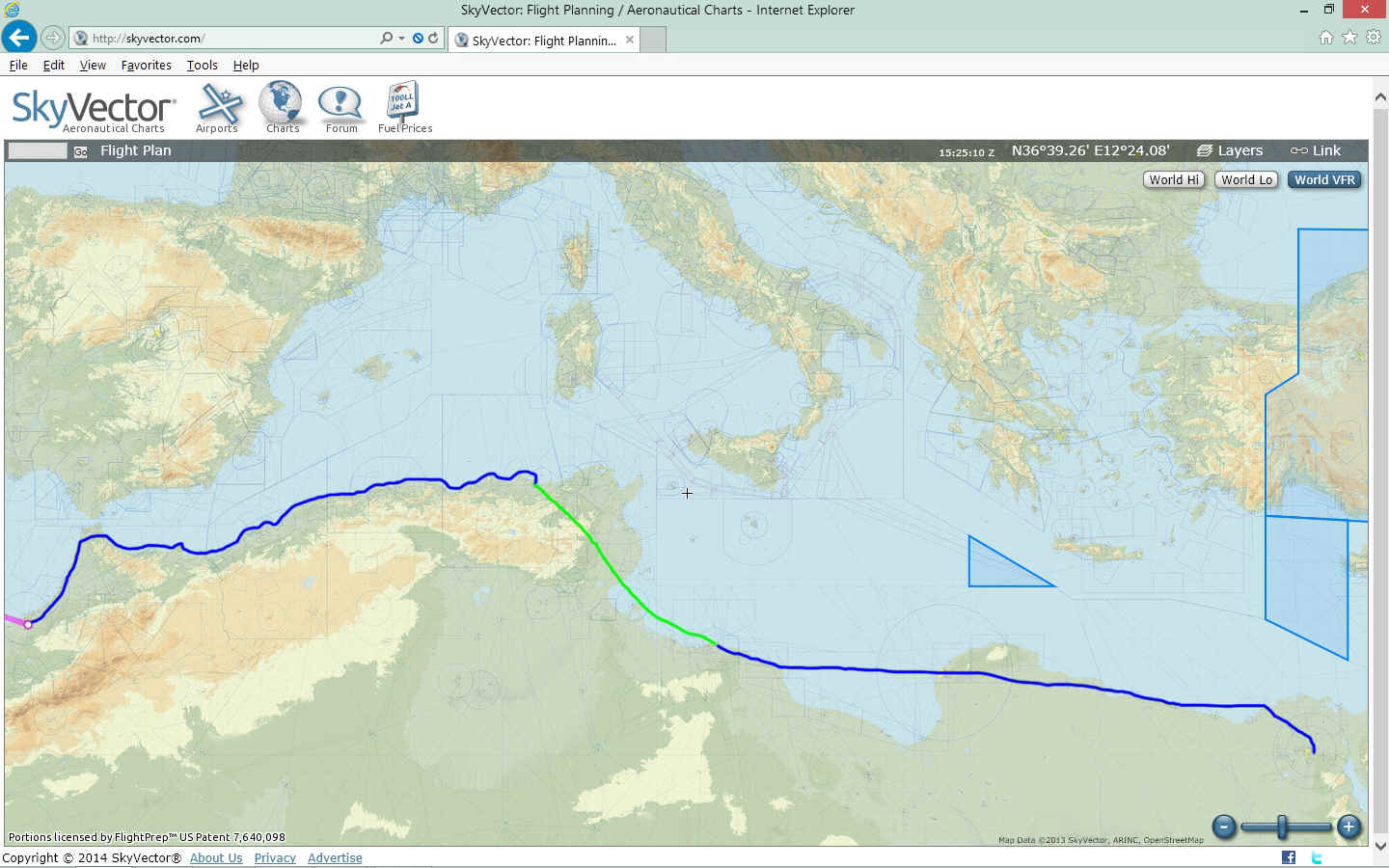
Her flight out of Casablanca was along the shore line heading north.
About 20 miles south of Tangier, she could see across the land to the Mediterranean Sea
and turned west to save some time. At this point, it was about 45 miles from the
Atlantic Ocean to the Mediterranean Sea.
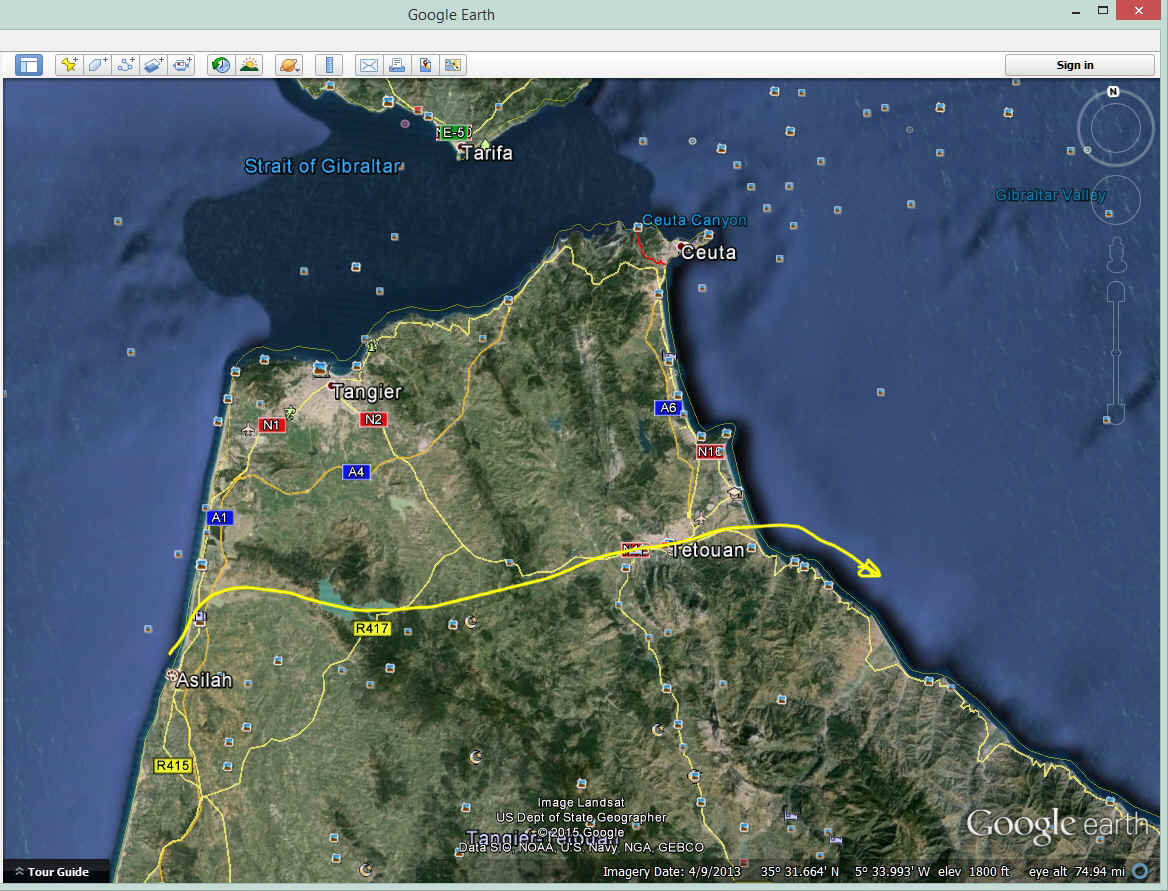
She talked about seeing vineyards not far from the Atlantic Ocean as she turned
westward toward the green hills and ridges. The clouds were high enough here she
did not have to worry about flying through a mountain pass. I put my mouse on the
highest elevation of 1,800 feet MSL along this route. You can see that information at the
bottom right of the photo above. The view below is looking from the Atlantic Coast
inland toward the lake seen in the image above near the R417 highway.
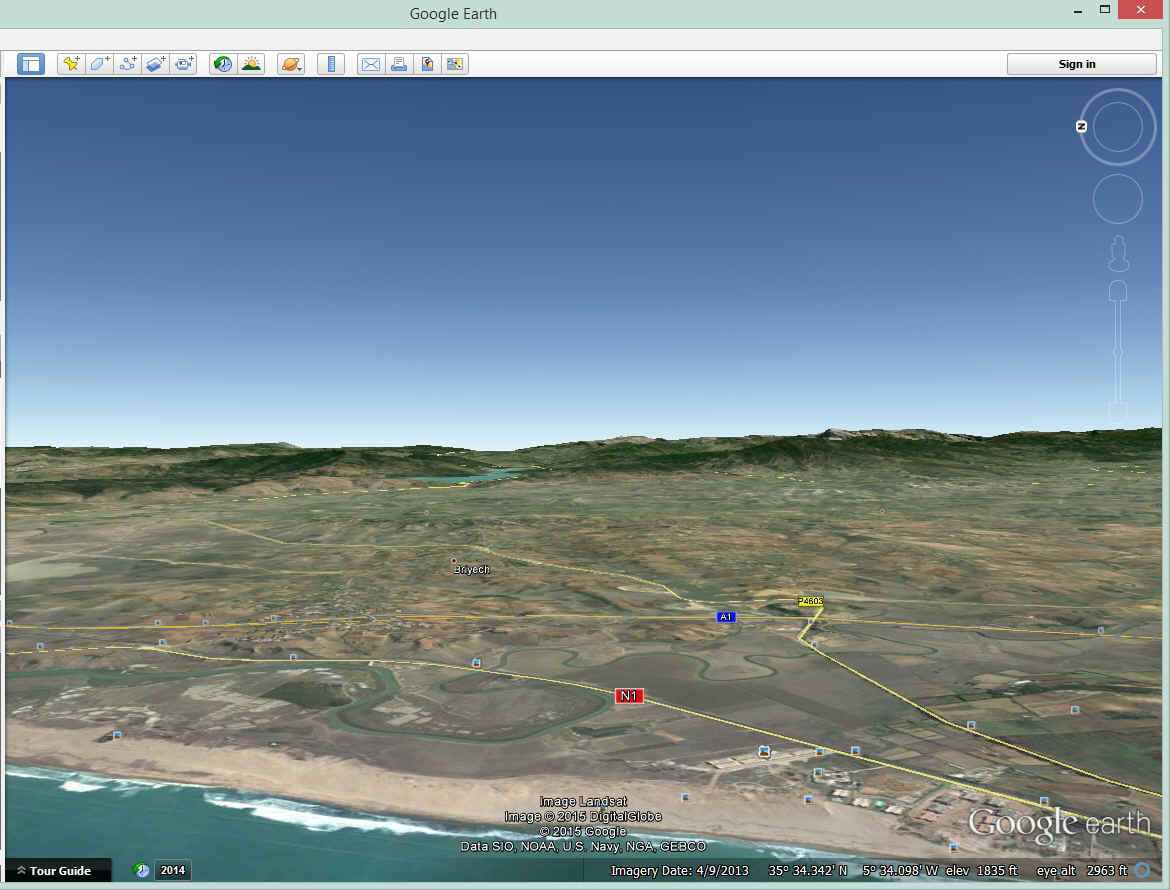
Here is the view over the lake and heading west toward higher ground.

This one is looking out the other side of the short cut with the Mediterranean
coast ahead.
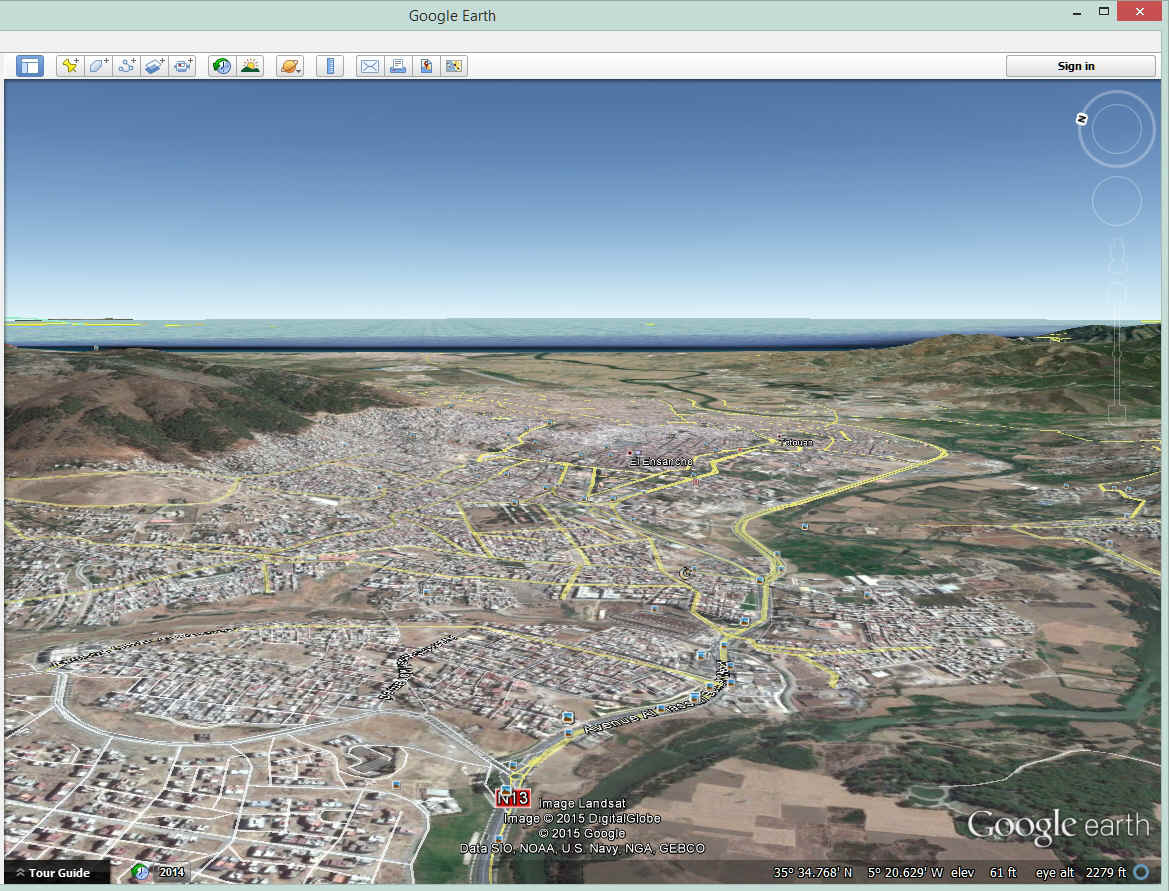
The Tetouan airport has a VOR on the field and a low-frequency NDB nearby.
This location would be easy for Jerrie to find from the Atlantic Ocean shoreline as
part of the shortcut. This image shows the airport as it is today. One thing
is for sure, from an altitude of 3,000 feet, the strait of Gibraltar is visible only 37
miles north when the weather is clear.
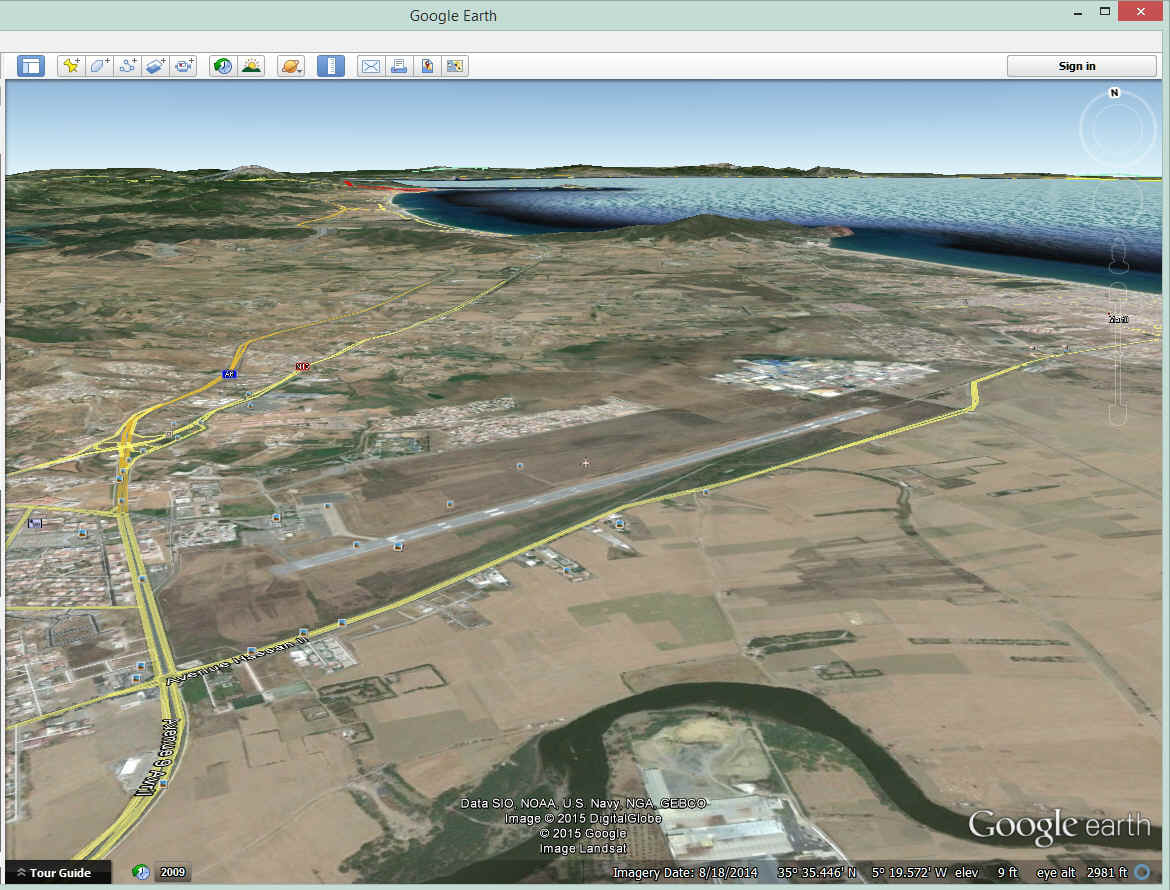
Jerrie described flying just off shore for hundreds of miles with land in sight
and low hanging haze that blocked the view of the mountains just inland. She watched
her charts and monitored the radio beacons along the way to keep up with her
position. She was flying in visual meteorological conditions (VMC) heading
East. As she got closer to her destination, she encountered a wall of rain and a
thunder storm blocking her view ahead. I have captured the image below from Google
Earth to get some idea of the area she described. This image is a clear sky
representation from Google Earth but not on that day in 1964. Now consider what it
would look like if you could not see anything but mist and fog above the white line I have
drawn. The yellow line indicates where her view ahead was blocked by heavy rain and
the thunder storm that also covered the high ground and part of the valley beyond at her
destination. She was circling in a bay seen here under the word
"mountains" for about 45 minutes waiting for the weather to clear. There
were a number of boats in the bay to help give her a sense of her location.

Here is my attempt to draw in the clouds and bad weather described in the photo
above.
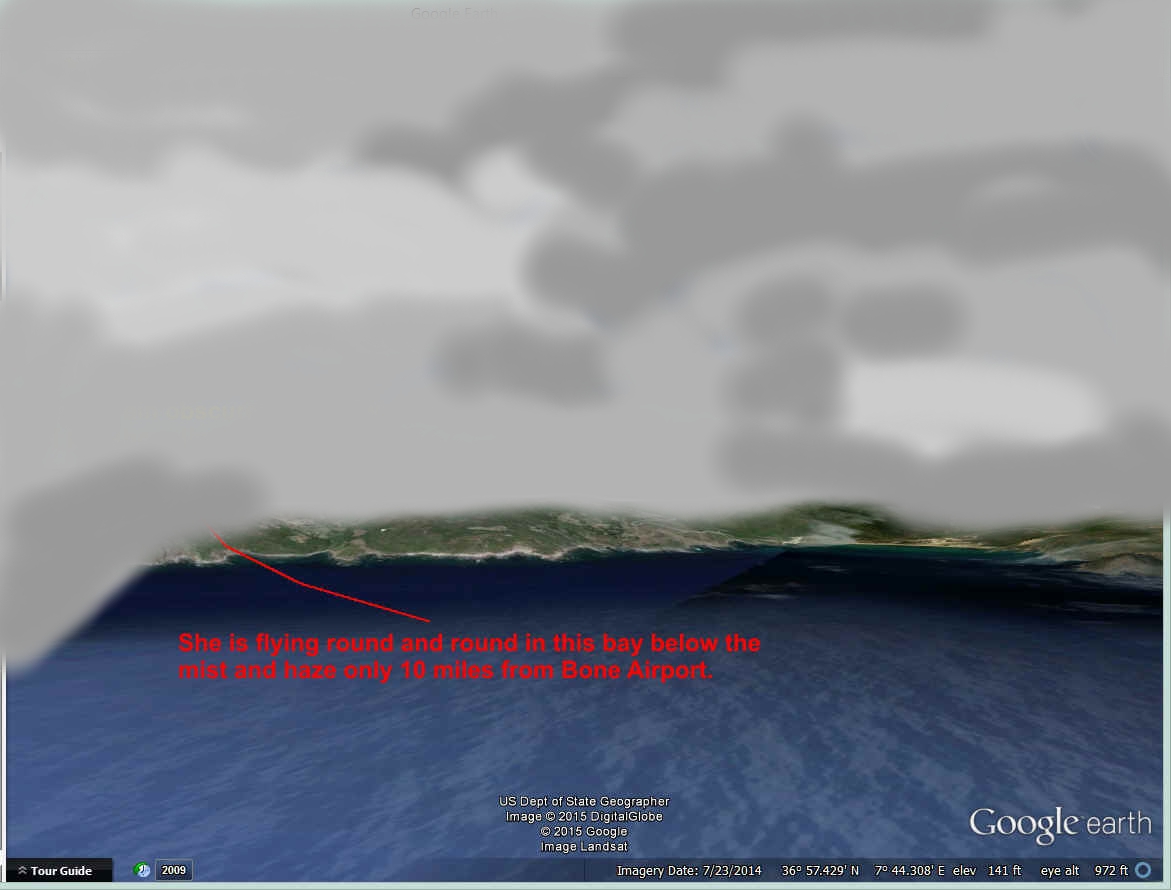
She was receiving the VOR beacon at the Bone Airport, but could not get past
the storm that blocked her view of the peninsula with its ridges that reached up over
1,200 feet above the sea. The RED line shows her circling position at about 10 miles
from the airport.

When the rain stopped, she flew from the bay around the point. The
weather cleared during her approach to the Bone Airport at sunset, seen here in a modern
image from Google Earth. I always love to see a runway ahead of me at the end of a
flight. Jerrie arrived just before sunset with some standing water on the runway and
taxiways left over from the storm that had just passed. This view is how the
approach probably looked to her. The storm clouds are not seen in the distance
beyond the airport since Google Earth is about seeing everything possible using images
that have only good weather.
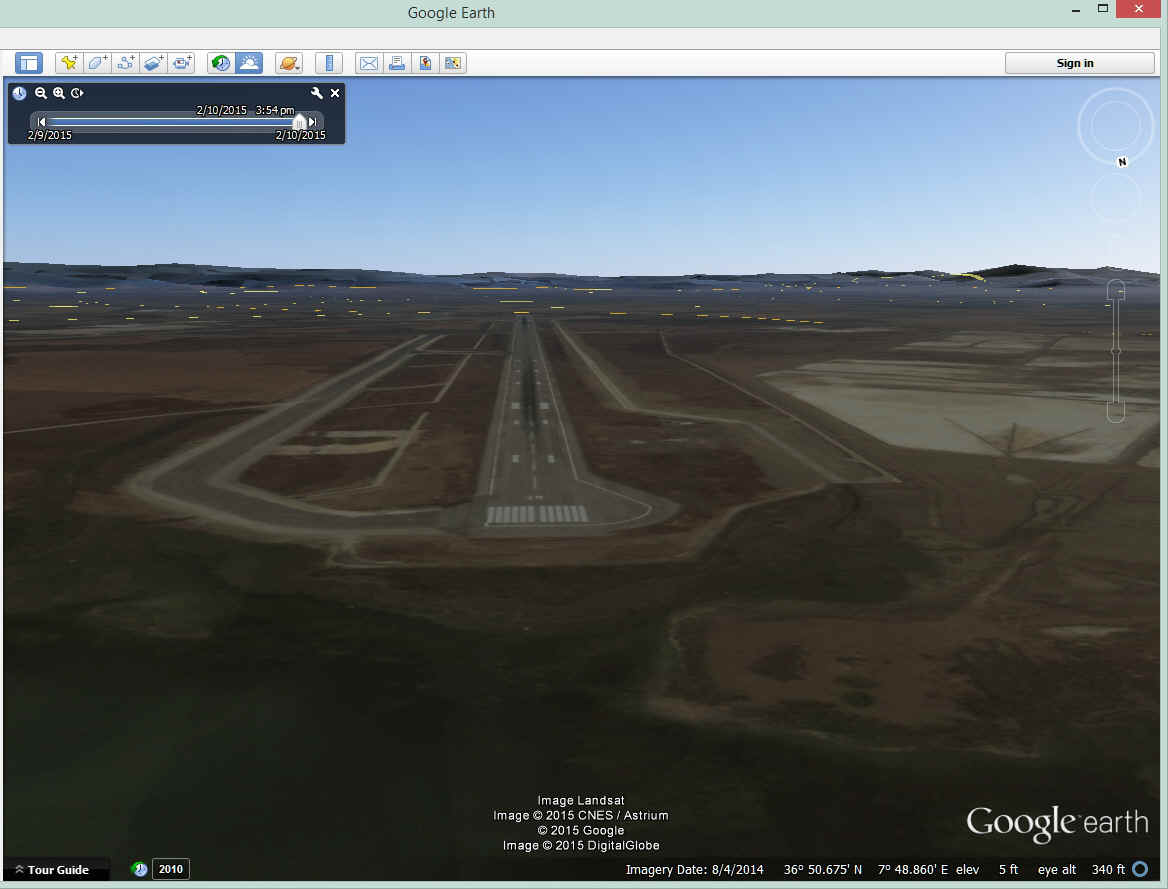
She described some airport details after she parked 38 Charlie on the ramp. They still had old metal deck plates used by the US Army Air Corps in World War II. This airport was also used by the Luftwaffe before the Allies pushed the Germans back toward Tunisia. There is a lot of history in North Africa, both older and from the 20th Century.
June 14, 2015: I first tried two Google Earth GPS files to show this flight. The first one I did was based on the 2007 images on Google Earth. It showed the airport where she departed Casablanca. The images that Google Earth displayed were based on the information in my "2007" file. That resulted in poor graphics in some areas of this route. By changing the year from 2007 to another year closer to NOW, there are better images to see during the "flight" on Google Earth. I also noticed the original coordinates for the GPS track I created MOVED its position on the newer images. Apparently there were some geospatial errors in the Google Earth map files for latitude and longitude that were corrected after 2007. When I updated my Casablanca to Bone file, the landing was not on the runway centerline at Bone as I created it using the 2007 images. The new GPS files uploaded today show the arrival from Santa Maria to Casablanca with an older Google Earth image file. The departure from Casablanca is the newest image file and the Anfa Airport is GONE. You will see the land and removed runway terrain departing Casablanca. The rest of the flight has the latest graphic images with rich details.
June 19,2015: I have updated the GPS files from Casablanca to Bone, Algeria. As of today, a GPS log file for a takeoff from Casablanca has been added to show the airport before it was closed and destroyed. After the Jerrie_Mock_Flights3.gdb file is loaded into Google Earth, you must select a few options from the menu to see all the features of the flights from Casablanca. Click on the View drop down menu and select SUN, and click again to select Historical Imagery. Then click Tools and options in the drop down menu. When the Options window opens, click on the 3D View tab if it not already selected. On this 3D menu, find the Atmosphere box and check the little box next to "Use photorealistic atmosphere rendering (EXPERIMENTAL). These settings apply to all the Jerrie Mock flights. For now, the only flight that needs the Historical Imagery option is the 2007 departure from Casablanca. The sun and atmosphere options will show the changing sun angle effects of lighting up the terrain, sunrise, sunset, and stars for the overnight flights.
Look at the screen capture below from Google Earth with the
Jerrie_Mock_Flights3.gdb file loaded. The three checked GPS tracks are displayed
together on the view from space. Select only ONE file at a time that you want to
"fly" and un-check all others. When you start the flight, the title of
that GPS log file will be displayed on your computer screen. Un-check that file in
the Sidebar menu to make it disappear from your view screen and enjoy the virtual flight.
To get a better view of the scenery, click on the View drop down menu and turn off
the Sidebar menu.
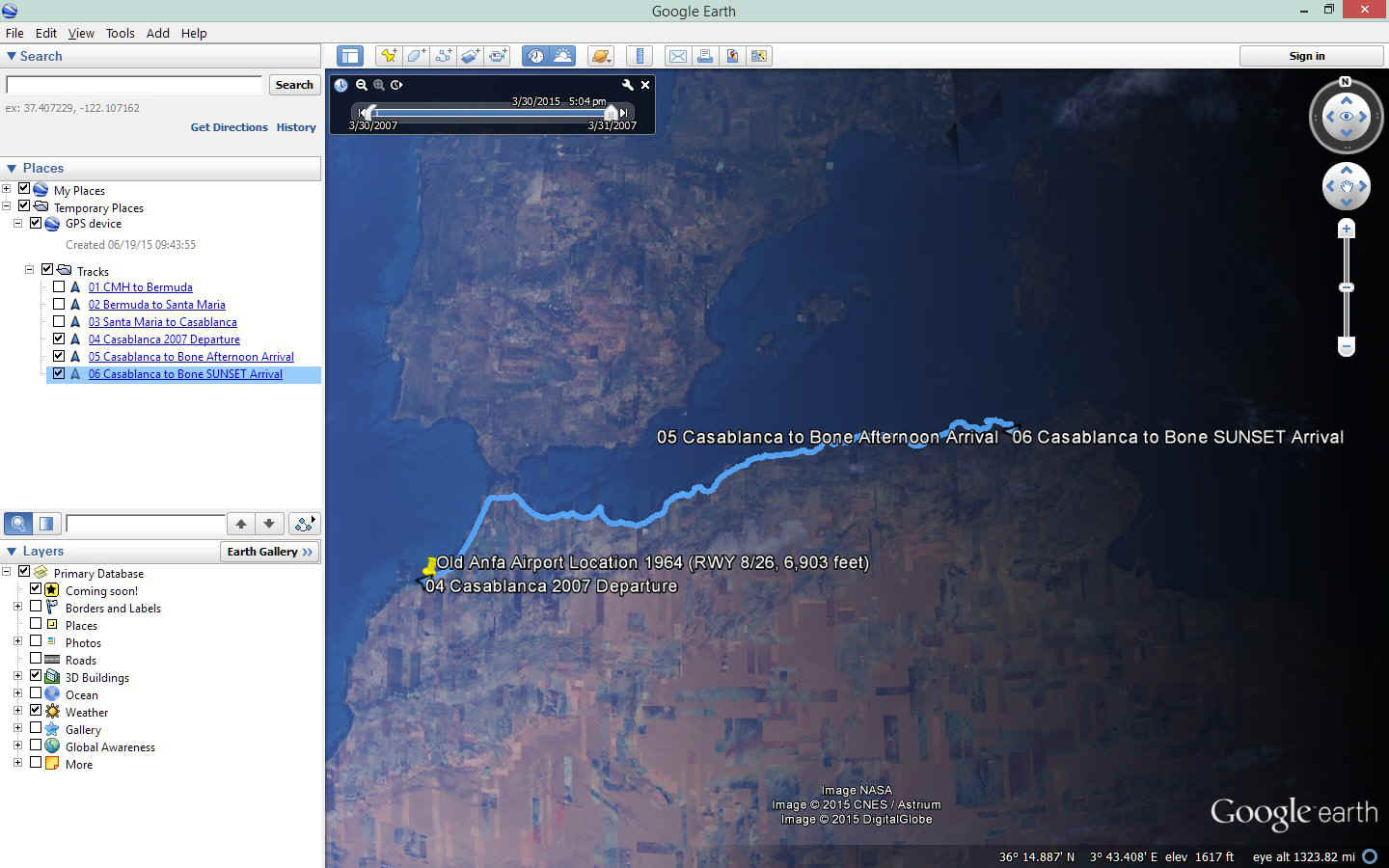
Here is a sun angle view for an afternoon holding pattern about 10 miles from
the Bone Airport as seen near the end of the After Noon Arrival GPS log file. Google
Earth shows good weather in this simulation, but there was rain and low clouds on the EAST
side of this bay where she circled for 45 minutes. I created only two circles over
this bay to show the terrain here. I figured you would not want a long delay in this
virtual flight.
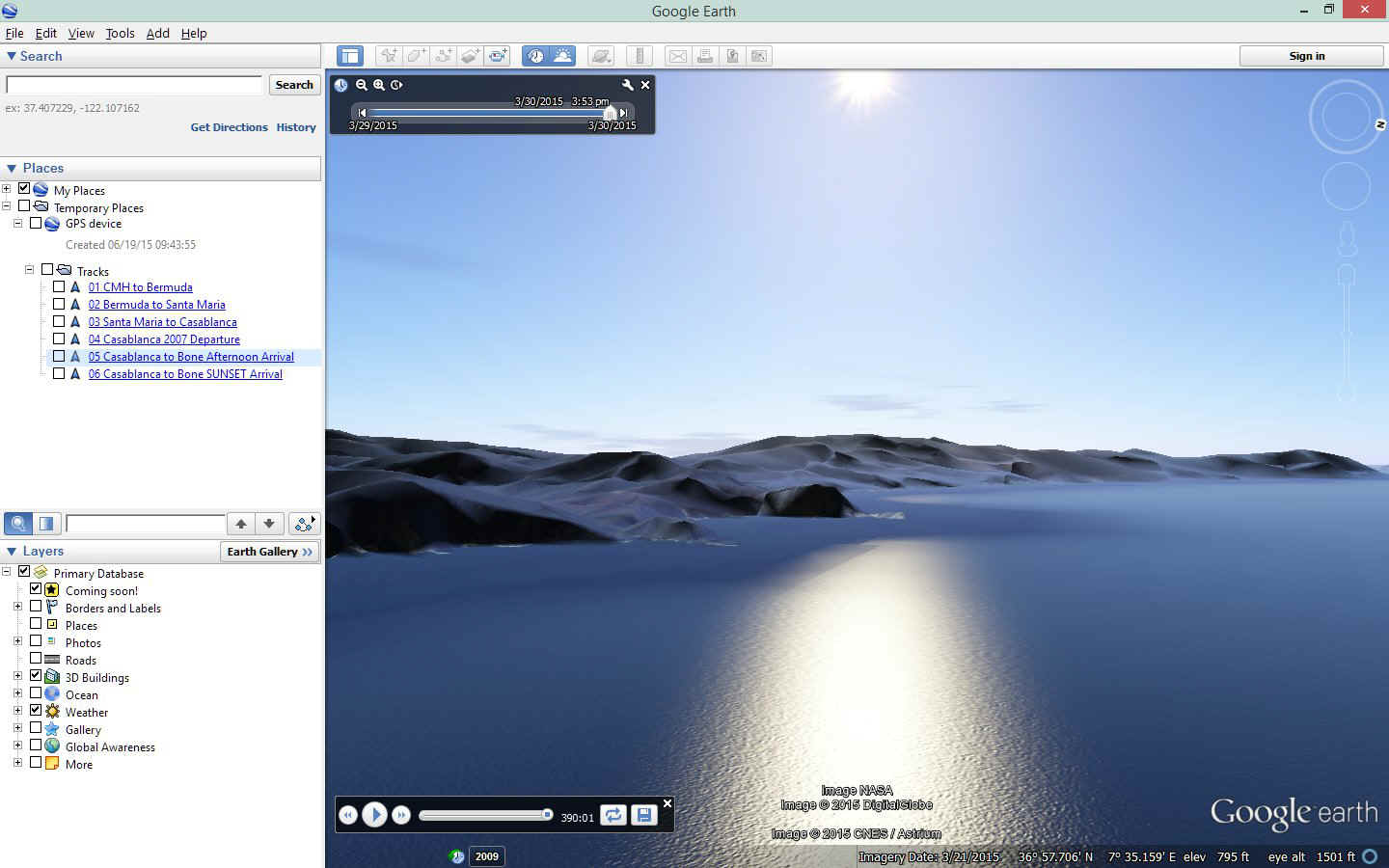
Here is the Google Earth ambient lighting from that same GPS log flight on
approach to the runway at Bone Airport

These next two images show the conditions ONE HOUR later as a comparison with
the sun 15 degrees lower in the sky.
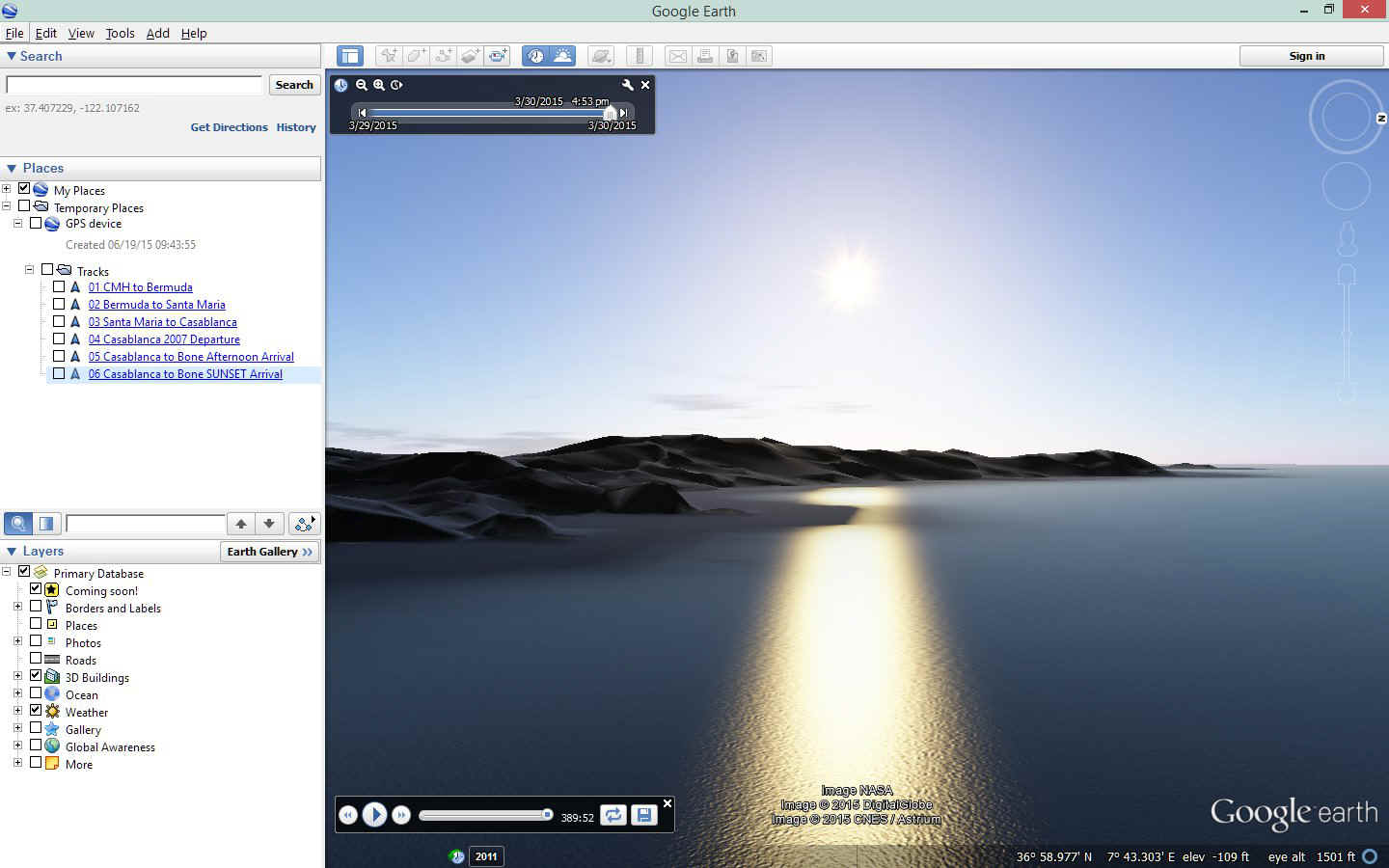
The lower sun angle reduced the light level at the airport. This chapter
in the book does not give a takeoff or landing time for this flight. If I had to
guess, she probably landed at a time between these two examples. From her
descriptions in the book, it was night time before she cleared customs and left the
airport. There were no other airplanes on the field and no taxi cabs. The
airline flights for this day had come and gone before she arrived. An airport
employee gave her a ride to the hotel in town.

| CLICK HERE for PAGE 5 | CLICK for Jerrie Mock MENU | Return to N2PRISE MAIN MENU |